한국응용과학기술학회 논문 검색
.jpg)
Novel binding material as petroleum pitch/polymer composite for lithium-ion battery
간행물 정보 : Vol. 42 No. 1, 2025년,
파일형식 : pdf

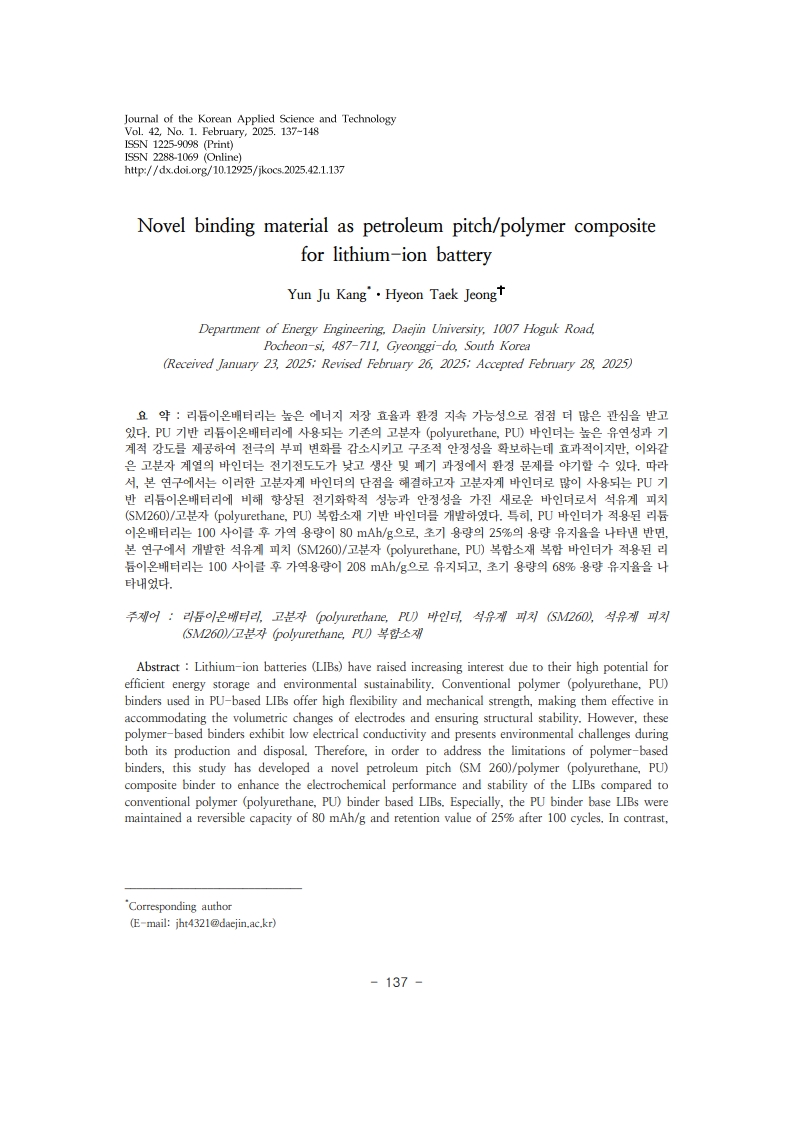
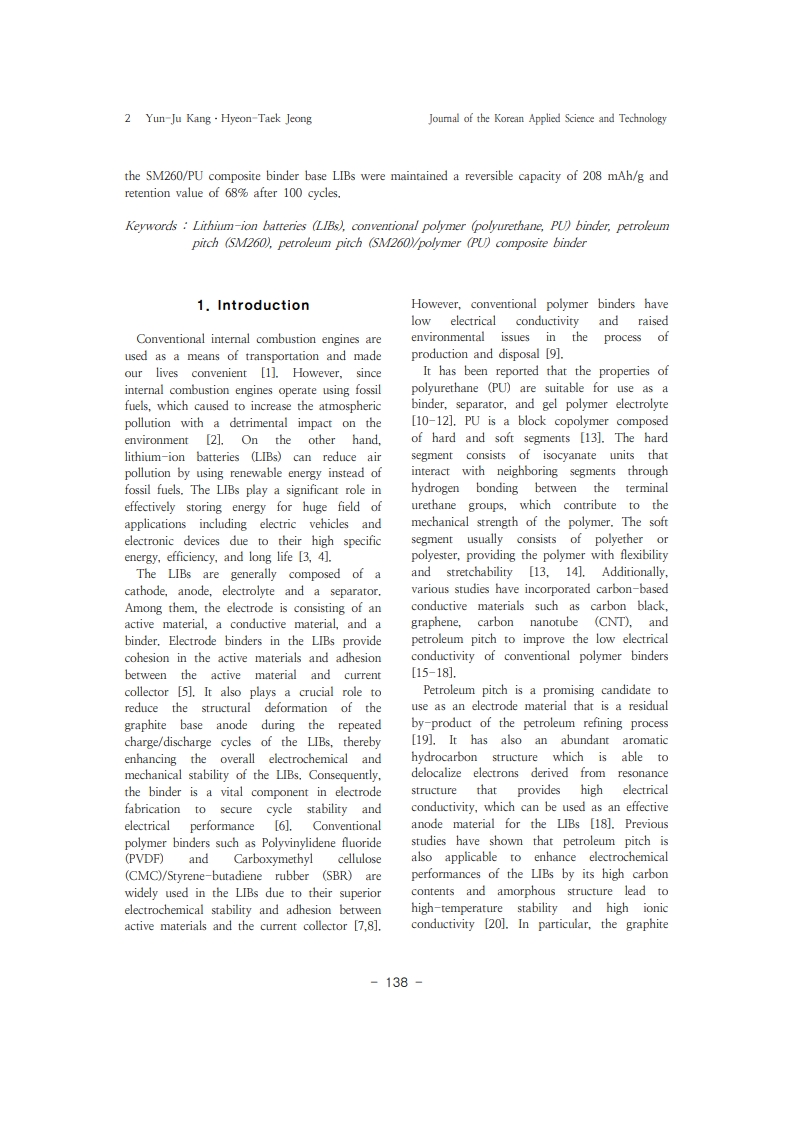
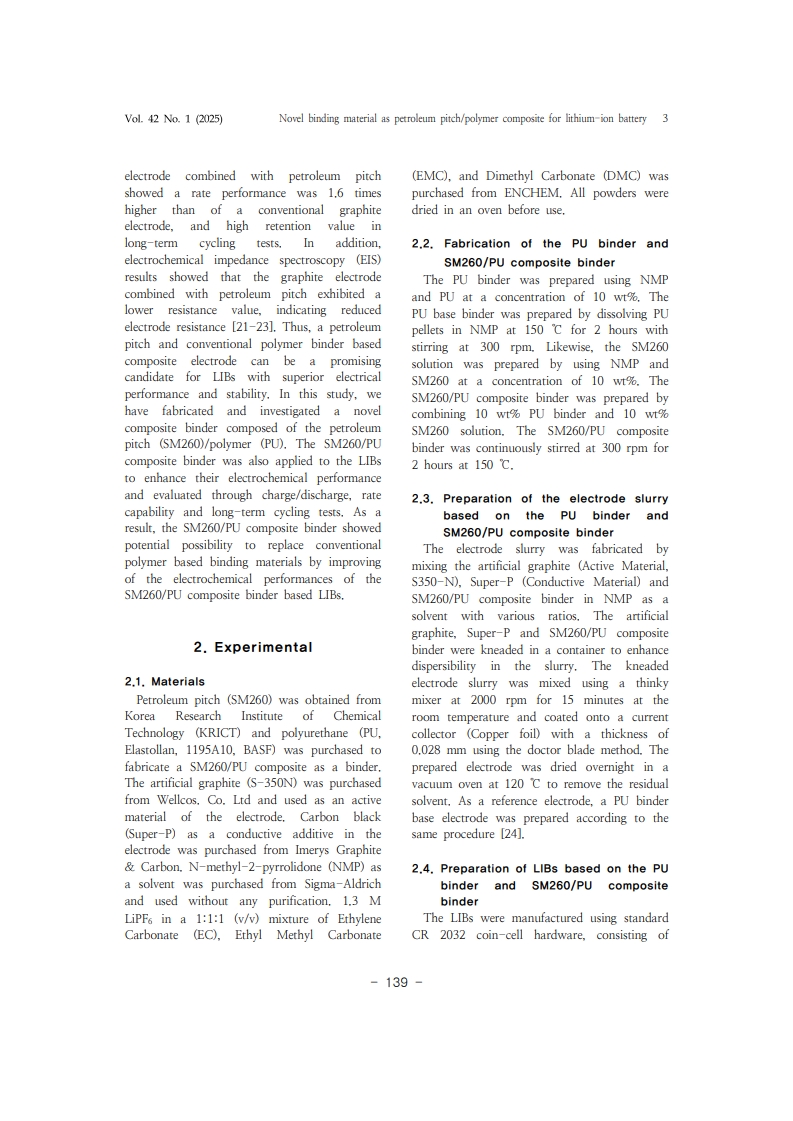

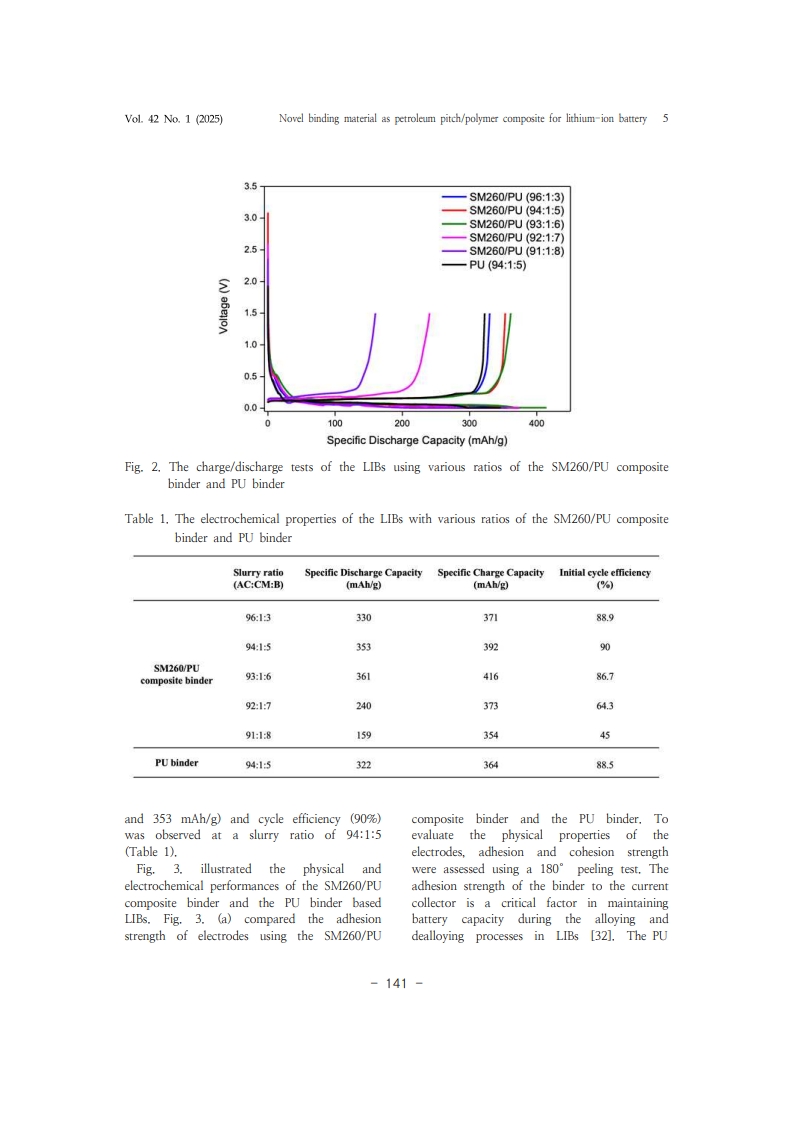
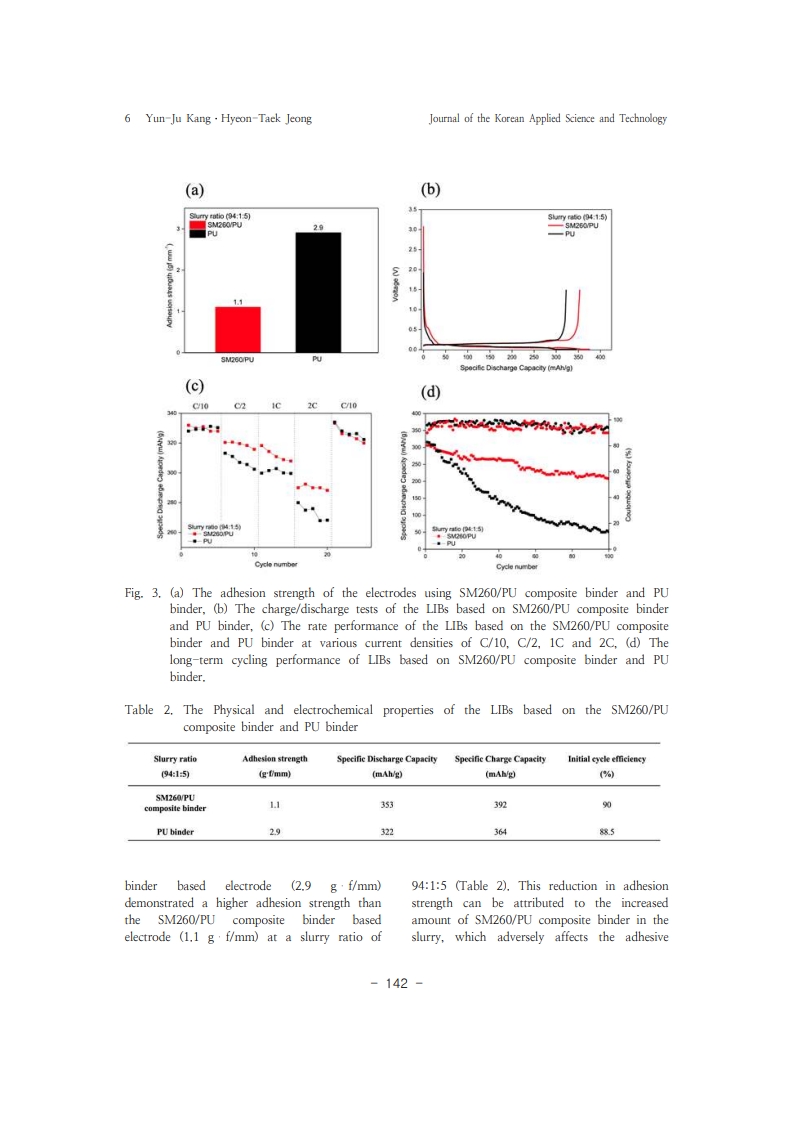
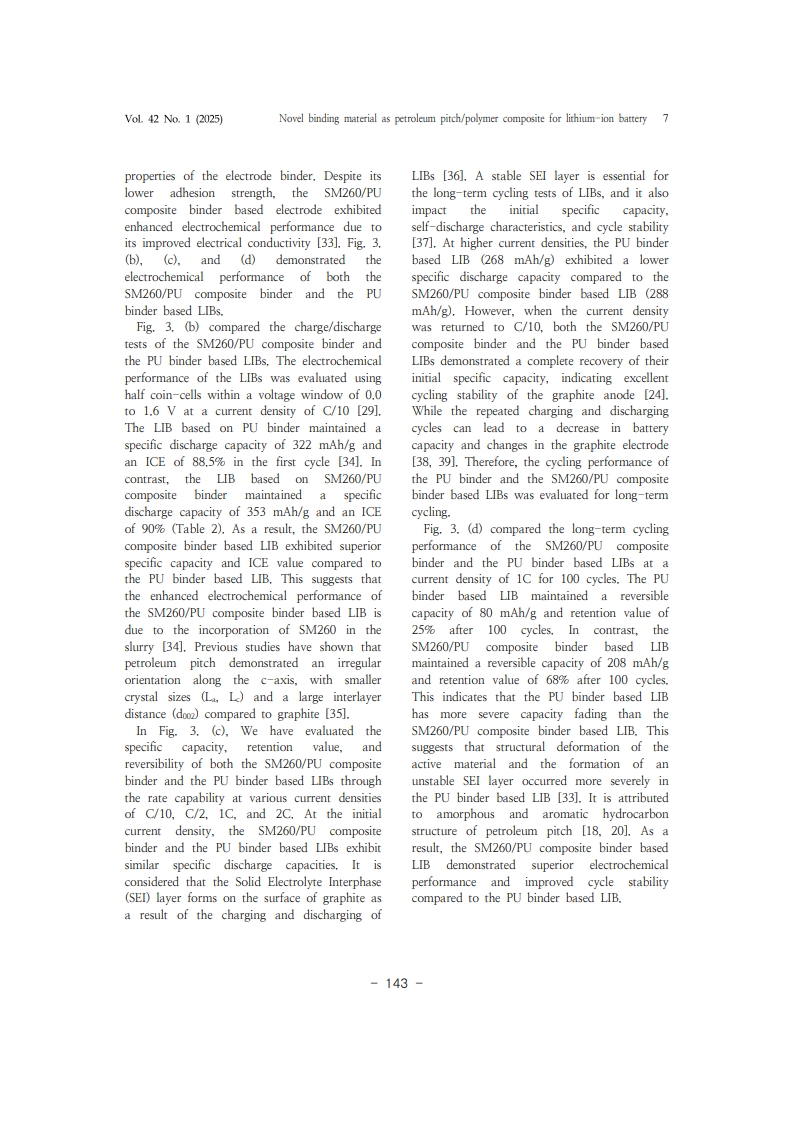
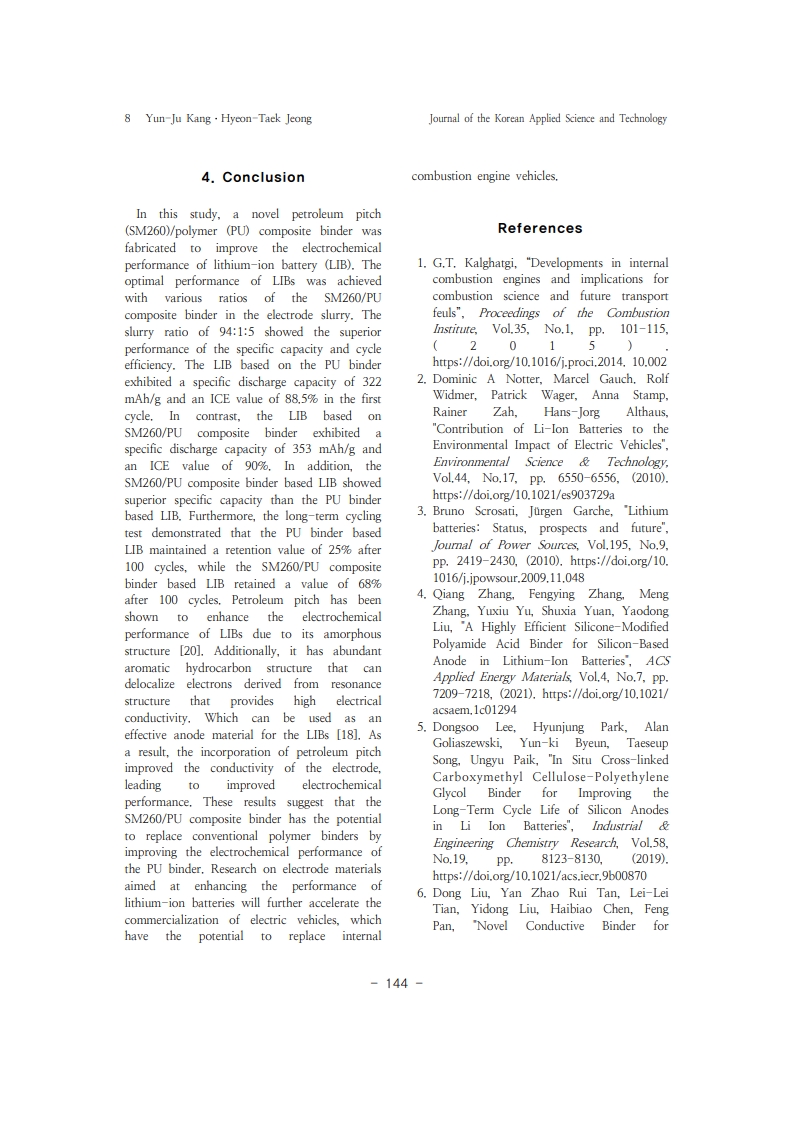

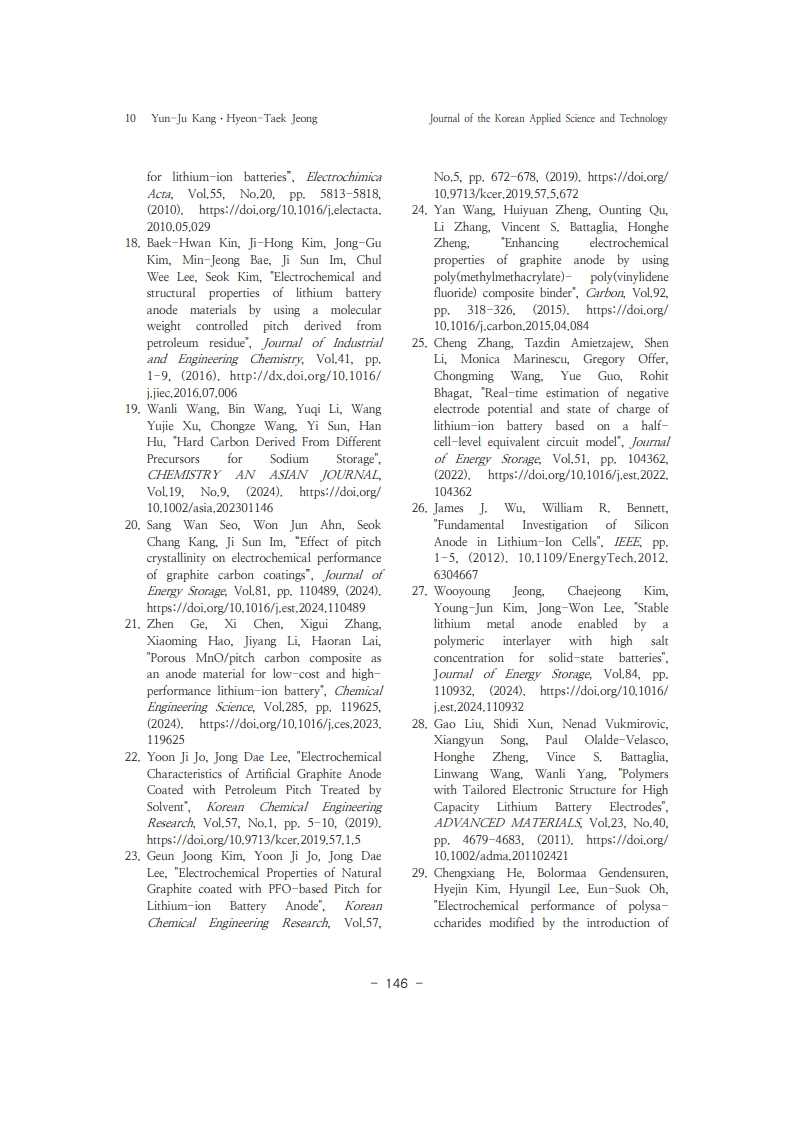

 1. G.T. Kalghatgi, “Developments in internal combustion engines and implications for combustion science and future transport feuls”, Proceedings of the Combustion
1. G.T. Kalghatgi, “Developments in internal combustion engines and implications for combustion science and future transport feuls”, Proceedings of the Combustion
Institute, Vol.35, No.1, pp. 101-115, ( 2 0 1 5 ) .https://doi.org/10.1016/j.proci.2014.10.002
2. Dominic A Notter, Marcel Gauch. Rolf Widmer, Patrick Wager, Anna Stamp,Rainer Zah, Hans-Jorg Althaus, "Contribution of Li-Ion Batteries to the
Environmental Impact of Electric Vehicles", Environmental Science & Technology,Vol.44, No.17, pp. 6550-6556, (2010). https://doi.org/10.1021/es903729a
3. Bruno Scrosati, Jürgen Garche, "Lithium batteries: Status, prospects and future",Journal of Power Sources, Vol.195, No.9, pp. 2419-2430, (2010).
https://doi.org/10.1016/j.jpowsour.2009.11.048
4. Qiang Zhang, Fengying Zhang, Meng Zhang, Yuxiu Yu, Shuxia Yuan, YaodongLiu, "A Highly Efficient Silicone-Modified Polyamide Acid Binder for Silicon-Based
Anode in Lithium-Ion Batteries", ACS Applied Energy Materials, Vol.4, No.7, pp.7209-7218, (2021). https://doi.org/10.1021/acsaem.1c01294
5. Dongsoo Lee, Hyunjung Park, Alan Goliaszewski, Yun-ki Byeun, TaeseupSong, Ungyu Paik, "In Situ Cross-linked Carboxymethyl Cellulose-Polyethylene
Glycol Binder for Improving the Long-Term Cycle Life of Silicon Anodesin Li Ion Batteries", Industrial & Engineering Chemistry Research, Vol.58,
No.19, pp. 8123-8130, (2019). https://doi.org/10.1021/acs.iecr.9b00870
6. Dong Liu, Yan Zhao Rui Tan, Lei-Lei Tian, Yidong Liu, Haibiao Chen, FengPan, High-Performance Silicon Anodes in Lithium Ion Batteries", Nano Energy, Vol.36, pp. 206-212, (2017). https://doi.org/10.1016/j.nanoen.2017.04.043
7. Yoon-Soo Park, Eun-Suok Oh, Sung-Man Lee, "Effect of polymeric binder type on the thermal stability and tolerance to roll-pressing of spherical natural graphite
anodes for Li-ion batteries", Journal of Power Sources, Vol.248, pp. 1191-1196,(2014). https://doi.org/10.1016/j.jpowsour.2013.10.076
8. Sebastial Müllner, Tobias Michlik, Michael Reichel, Tilo Held, Ralf Moos, Christina Roth, "Effect of Water-Soluble CMC/SBRBinder Ratios on Si-rGO Composites Using µm- and nm-Sized Silicon as AnodeMaterials for Lithium-Ion Batteries", Batteries, Vol.9, No.5, pp. 248, (2023).
https://doi.org/10.3390/batteries9050248
9. M. Mancini, F. Nobili, R. Tossici, M. Wohlfahrt-Mehrens, R. Marassi, “Highperformance, environmentally friendly and low cost anodes for lithium-ion battery
based on TiO2 anatase and water soluble binder carboxymethyl cellilose”, Jounal ofPower Sources, Vol.196, No.22, pp. 9665-9671, (2011).
https://doi.org/10.1016/j.jpowsour.2011.07.028
10. Geun-gyung Park, Yang-kyu Park, Joon-ki Park, Jae-won Lee, "Flexible andwrinkle-free electrode fabricated with polyurethane binder for lithium-ion
batteries", RSC Advances, Vol.7, No.26, pp. 16244-16252, (2017). DOI:https://doi.org/10.1039/c7ra00800g
11. Yan Liu, Runming Tao, Shengrui Chen, Kai Wu, Zhaofeng Zhong, Ji Tu, Pingmei Guo, Honghao Liu, Shun Tang, Jiyuan Liang, Yuan-Cheng Cao, "A novel
polyurethane-LiF artificial interface protective membrane as a promisingsolution towards high-performance lithium metal batteries", Journal of Power Sources, Vol.477, pp. 228694, (2020).https://doi.org/10.1016/j.jpowsour.2020.228694
12. Muhammad Syukri Mohamad Misenan, Azwani Sofia Ahmad Khiar, Tarık Eren,"Polyurethane-based polymer electrolyte for lithium ion batteries: a review", Polymer International, Vol.71, No.7, pp. 751-769, (2022).https://doi.org/10.1002/pi.6395
13. Naiqing Ren, Youxin Song, Can Tao, Bing Cong, Qin Cheng, Yiping Huang, Gewen Xu, Junjie Bao, "Effect of the soft and hard segment composition on the
properties of waterborne polyurethanebasedsolid polymer electrolyte for lithiumion batteries", Journal of Solid State Electrochemistry, Vol.22, No.4, pp.
1109-1121, (2018). https://doi.org/10.1007/s10008-017-3855-1
14. Yong-Hee Lee, Joo-Seong Kim, Jonghyeon Noh, Inhwa Lee, Hyeong Jun Kim,Sunghun Choi, Jeongmin Seo, Seokwoo Jeon, Taek-soo Kim, Jung-Yong Lee, Jang
Wool Choi, "Wearable Textile Battery Rechargeable by Solar Energy", NanoLetters, Vol.13, No.11, pp. 5753-5761, (2013). https://doi.org/10.1021/nl403860k
15. Xuesong Lu, Guo J. Lian, James Parker, Ruihuan Ge, Milan K. Sadan, Rachel M.Smith, Denis Cumming, "Effect of carbon blacks on electrical conduction and
conductive binder domain of nextgenerationlithium-ion batteries", Journalof Power Sources, Vol.592, pp. 233916, (2024).
https://doi.org/10.1016/j.jpowsour.2023.233916
16. Xiaolan Chen, Wanzheng Lu, Chen Chen, Mingzhe Xue, “Improved Electrochemical Performance of LiNi0.5Co0.2Mn0.3O2 Cathodewith Different Carbon Additives for Lithium-ion Batteries”, International Journalof Electrochemical Science, Vol.13, No.1, pp. 296-304, (2018).
https://doi.org/10.20964/2018.01.42
17. Nan Zhu, Wen Liu, Mianqi Xuea, Zhuang Xiea, Dan Zhao, Meining Zhang, JitaoChen, Tingbing Cao, “Graphene as a conductive additive to enhance the highrate
capabilities of electrospun Li4Ti5O1210 for lithium-ion batteries”, ElectrochimicaActa, Vol.55, No.20, pp. 5813-5818, (2010).
https://doi.org/10.1016/j.electacta.2010.05.029
18. Baek-Hwan Kin, Ji-Hong Kim, Jong-Gu Kim, Min-Jeong Bae, Ji Sun Im, ChulWee Lee, Seok Kim, "Electrochemical and structural properties of lithium battery
anode materials by using a molecular weight controlled pitch derived frompetroleum residue", Journal of Industrial and Engineering Chemistry, Vol.41, pp.
1-9, (2016). http://dx.doi.org/10.1016/j.jiec.2016.07.006
19. Wanli Wang, Bin Wang, Yuqi Li, Wang Yujie Xu, Chongze Wang, Yi Sun, HanHu, "Hard Carbon Derived From Different Precursors for Sodium Storage",
CHEMISTRY AN ASIAN JOURNAL, Vol.19, No.9, (2024).https://doi.org/10.1002/asia.202301146
20. Sang Wan Seo, Won Jun Ahn, Seok Chang Kang, Ji Sun Im, “Effect of pitchcrystallinity on electrochemical performance of graphite carbon coatings”, Journal of Energy Storage, Vol.81, pp. 110489, (2024).https://doi.org/10.1016/j.est.2024.110489
21. Zhen Ge, Xi Chen, Xigui Zhang, Xiaoming Hao, Jiyang Li, Haoran Lai,"Porous MnO/pitch carbon composite as an anode material for low-cost and highperformancelithium-ion battery", Chemical Engineering Science, Vol.285, pp. 119625, (2024). https://doi.org/10.1016/j.ces.2023.119625
22. Yoon Ji Jo, Jong Dae Lee, "Electrochemical Characteristics of Artificial Graphite Anode Coated with Petroleum Pitch Treated by Solvent", Korean Chemical Engineering Research, Vol.57, No.1, pp. 5-10, (2019).https://doi.org/10.9713/kcer.2019.57.1.5
23. Geun Joong Kim, Yoon Ji Jo, Jong Dae Lee, "Electrochemical Properties of Natural Graphite coated with PFO-based Pitch for Lithium-ion Battery Anode", Korean Chemical Engineering Research, Vol.57, No.5, pp. 672-678, (2019). https://doi.org/10.9713/kcer.2019.57.5.672
24. Yan Wang, Huiyuan Zheng, Ounting Qu, Li Zhang, Vincent S. Battaglia, HongheZheng, "Enhancing electrochemical properties of graphite anode by using
poly(methylmethacrylate)- poly(vinylidene fluoride) composite binder", Carbon, Vol.92,pp. 318-326, (2015). https://doi.org/10.1016/j.carbon.2015.04.084
25. Cheng Zhang, Tazdin Amietzajew, Shen Li, Monica Marinescu, Gregory Offer,Chongming Wang, Yue Guo, Rohit Bhagat, "Real-time estimation of negative
electrode potential and state of charge of lithium-ion battery based on a halfcell-levelequivalent circuit model", Journal of Energy Storage, Vol.51, pp. 104362, (2022). https://doi.org/10.1016/j.est.2022.104362
26. James J. Wu, William R. Bennett, "Fundamental Investigation of Silicon Anode in Lithium-Ion Cells", IEEE, pp. 1-5, (2012). 10.1109/EnergyTech.2012. 6304667
27. Wooyoung Jeong, Chaejeong Kim, Young-Jun Kim, Jong-Won Lee, "Stablelithium metal anode enabled by a polymeric interlayer with high salt
concentration for solid-state batteries", Journal of Energy Storage, Vol.84, pp.110932, (2024). https://doi.org/10.1016/j.est.2024.110932
28. Gao Liu, Shidi Xun, Nenad Vukmirovic, Xiangyun Song, Paul Olalde-Velasco,Honghe Zheng, Vince S. Battaglia, Linwang Wang, Wanli Yang, "Polymers
with Tailored Electronic Structure for High Capacity Lithium Battery Electrodes",ADVANCED MATERIALS, Vol.23, No.40, pp. 4679-4683, (2011).
https://doi.org/10.1002/adma.201102421
29. Chengxiang He, Bolormaa Gendensuren, Hyejin Kim, Hyungil Lee, Eun-Suok Oh,"Electrochemical performance of polysaccharides modified by the introduction of Vol. 42 No. 1 (2025) Novel binding material as petroleum pitch/polymer composite for lithium-ion battery 11SO3H as binder for high-powered Li4Ti5O12 anodes in lithium-ion batteries", Journal of Electroanalytical Chemistry, Vol.876, pp. 114532, (2020). https://doi.org/10.1016/j.jelechem.2020.114532
30. Chengrong Gu, Junying Hu, Xiankang Zhong, "The coating delamination mitigation of epoxy coatings by inhibiting the hydrogen evolution reaction", Progress in Organic Coatings, Vol.147, pp. 105774, (2020).https://doi.org/10.1016/j.porgcoat.2020.105774
31. Pankaj Arora, Ralph E. White and Marc Doyle, "Capacity Fade Mechanisms andSide Reactions in Lithium‐Ion Batteries", Journal of the Electrochemical Society, Vol.145, No.10, pp. 3647-3667, (1998). DOI https://doi.org/10.1149/1.1838857
32. Lei Luo, Yunlong Xu, Huang Zhang, Xiaona Han, Hui Dong, Xing Xu, ChaoChen, Yang Zhang, Jiahao Lin, "Comprehensive Understanding of High
Polar Polyacrylonitrile as an Effective Binder for Li-Ion Battery Nano-SiAnodes", ACS Applied Materials & Interfaces, Vol.8, No.12, pp. 8154-8161,
(2016). https://doi.org/10.1021/acsami.6b03046
33. Kyung Soo Kim, Ji Sun Im, Jong Dae Lee, Ji Hong Kim, Jin Ung Hwang, "Effects of Pitch Softening Point-based on Soft Carbon Anode for Initial Efficiency and
Rate Performance", Applied Chemistry for Engineering, Vol.30, No.3, pp. 331-336,(2019). DOI: https://doi.org/10.14478/ace.2019.1015
34. Lili Chai, Qunting Qu, Longfei Zhang, Ming Shen, Li Zhang, Honghe Zheng,"Chitosan, a new and environmental benign electrode binder for use with
graphite anode in lithium-ion batteries", Electrochimica Acta, Vol.105, pp. 378-383, (2013). https://doi.org/10.1016/j.electacta.2013.05.009
35. Bo-Ra Kim, Ji-Hong Kim, Ji-Sum Im, "Effect and Mechanism of Pitch Coating on the Rate Performance Improvement of Lithium-Ion Batteries", materials, Vol.15,
No.13, pp. 4713, (2022). https://doi.org/10.3390/ma15134713
36. Yikang Yu, Zhenzhen Yang, Yuzi Liu, Jian Xie, "Achieving SEI preformedgraphite in flow cell to mitigate initial lithium loss", Carbon, Vol.196, pp.
589-595, (2022). https://doi.org/10.1016/j.carbon.2022.05.024
37. Seong Jin An, Jianlin Li, Claus Daniel, Debasish Mohanty, Shrikant Nagpure,David L. Wood, "The state of understanding of the lithium-ion-battery
graphite solid electrolyte interphase (SEI) and its relationship to formation cycling",Carbon, Vol.105, pp. 52-76, (2016). https://doi.org/10.1016/j.carbon.2016.04.008
38. Kohei Nunotani, Fumiya Yoshida, Yusho Kamiya, Yasuhiro Daisho, Kazuo Abe,Michiyuki Kono, "Development and performance evaluation of lithium iron
phosphate battery with superior rapid charging performance - Second report:Evaluation of battery capacity loss characteristics", IEEE, pp. 1-4, (2011).
DOI: https://doi.org/10.1109/VPPC.2011.6042998
39. Nuria Cuesta, Alberto Ramos, Ignacio Cameán, Cristina Antuña, Ana B. García, “Hydrocolloids as binders for graphite anodes of lithium-ion batteries”, ElectrochimicaActa, Vo1.155, pp. 140-147, (2015).https://doi.org/10.1016/j.electacta.2014.12.122
40. Chih-Yu Chen, Ai-Hua Liang, ChengLiangHuang, Ting-Hao Hsu, Yuan-YanLi, "The pitch-based silicon-carbon composites fabricated by electro spraying
technique as the anode material of lithium ion battery", Journal of Alloys andCompounds, Vol.844, pp. 156025, (2020).
https://doi.org/10.1016/j.jallcom.2020.156025
41. Yanxia Che, Xiuyi Lin, Lindan Xing, Xiongcong Guan, Rude Guo, GuangyuanLan, Qinfeng Zheng, Wenguang Zhang, Weishan Li, interphases for high energy lithium-ion batteries with p-toluenesulfonyl fluoride electrolyte additive", Journal of Energy Chemistry, Vol.52, pp. 361-371, (2021).https://doi.org/10.1016/j.jechem.2020.04.023
42. F. Maroni, S. Gabrielli, A. Palmieri, E.Marcantoni, F. Croce, F. Nobili, "Highcycling stability of anodes for lithium-ion batteries based on Fe3O4 nanoparticles and poly(acrylic acid) binder", Journal of Power Sources, Vol.332, pp. 79-87, (2016). https://doi.org/10.1016/j.jpowsour.2016.09.106
43. Yuqing Chen, Yuqiong Kang, Yun Zhao, Li Wang, Jilei Liu, Yanxi Li, Zheng Liang, Xiangming He, Xiang Li, Naser Tavajohi, Baohua Li, "A review of lithium-ion
battery safety concerns: The issues, strategies, and testing standards", Journal of Energy Chemistry, Vol.59, pp. 83-99, (2021).
https://doi.org/10.1016/j.jechem.2020.10.017
44. Niranjanmurthi Lingappan, Lingxi Kong, Michael Pecht, "The significance ofaqueous binders in lithium-ion batteries", Renewable and Sustainable Energy
Reviews, Vol.147, pp. 111227, (2021). https://doi.org/10.1016/j.rser.2021.111227
45. Hao Chen, Min Ling, Luke Hencz, Han Yeu, Ling, Gaoran Li, Zhan Lin, Gao Liu, Shanqing Zhang, "Exploring Chemical, Mechanical, and Electrical Functionalities of Binders for Advanced Energy-Storage Devices", Chemical Reviews, Vol.118, No.18, pp. 8936-8982, (2018). https://doi.org/10.1021/acs.chemrev.8b00241
46. Hitoshi Yoshikawa, Tetsuo Hino, Noriyuki Kuramoto, "Effect of temperature andmoisture on electrical conductivity in polyaniline/polyurethane (PANI/PU) blends",
Synthetic Metals, Vol.156, No.18-20, pp. 1187-1193, (2006).https://doi.org/10.1016/j.synthmet.2006.08.007
